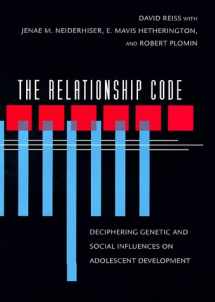
The Relationship Code: Deciphering Genetic and Social Influences on Adolescent Development (Adolescent Lives)
ISBN-13:
9780674000544
ISBN-10:
0674000544
Edition:
1
Author:
David Reiss, Robert Plomin, E. Mavis Hetherington, Jenae M. Neiderhiser
Publication date:
2000
Publisher:
Harvard University Press
Format:
Hardcover
560 pages
FREE US shipping
Book details
ISBN-13:
9780674000544
ISBN-10:
0674000544
Edition:
1
Author:
David Reiss, Robert Plomin, E. Mavis Hetherington, Jenae M. Neiderhiser
Publication date:
2000
Publisher:
Harvard University Press
Format:
Hardcover
560 pages
Summary
The Relationship Code: Deciphering Genetic and Social Influences on Adolescent Development (Adolescent Lives) (ISBN-13: 9780674000544 and ISBN-10: 0674000544), written by authors
David Reiss, Robert Plomin, E. Mavis Hetherington, Jenae M. Neiderhiser, was published by Harvard University Press in 2000.
With an overall rating of 3.6 stars, it's a notable title among other
books. You can easily purchase or rent The Relationship Code: Deciphering Genetic and Social Influences on Adolescent Development (Adolescent Lives) (Hardcover) from BooksRun,
along with many other new and used
books
and textbooks.
And, if you're looking to sell your copy, our current buyback offer is $0.58.
Description
The Relationship Code is the report of a longitudinal study, conducted over a ten-year period, of the influence of family relationships and genetic factors on competence and psychopathology in adolescent development. The sample for this landmark study included 720 pairs of same-sex adolescent siblings--including twins, half siblings, and genetically unrelated siblings--and their parents. Using a clear expressive style, David Reiss and his coinvestigators identify specific mechanisms that link genetic factors and the social environment in psychological development. They propose a striking hypothesis: family relationships are crucial to the expression of genetic influences on a broad array of complex behaviors in adolescents. Moreover, this role of family relationships may be very specific: some genetic factors are linked to mother-child relationships, others to father-child relations, some to relationship warmth, while others are linked to relationship conflict or control. The specificity of these links suggests that family relationships may constitute a code for translating genetic influences into the ontogeny of behaviors, a code every bit as important for behavior as DNA-RNA.


We would LOVE it if you could help us and other readers by reviewing the book
Book review

Congratulations! We have received your book review.
{user}
{createdAt}
by {truncated_author}


